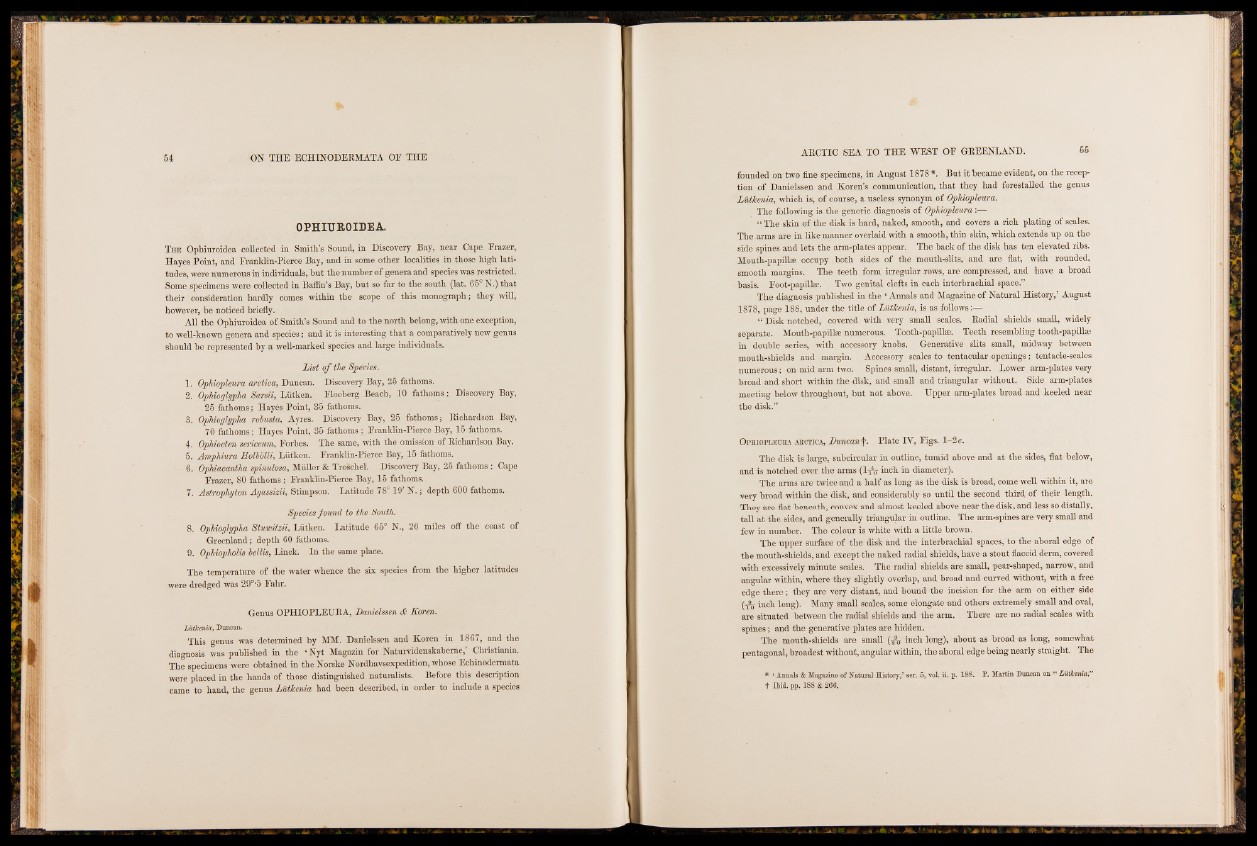
OPHIUROIDEA.
T h e Ophiuroidea collected in Smith’s Sound, in Discovery Bay, near Cape Frazer,
Hayes Point, and Franklin-Pierce Bay, and in some other localities in those high latitudes,
were numerous in individuals, but the number of genera and species was restricted.
Some specimens were-Collected in Baffin’s Bay, but so far to the south (lat. 65 N.) that
their consideration hardly comes within the scope of this monograph; they will,
however, be noticed briefly.
All the Ophiuroidea of Smith’s Sound and to the north belong, with one exception,
to well-known genera and species; and it is interesting that a comparatively new genus
should be represented by a well-marked species and large individuals.
List o f the Species.
1. Ophiopleura arctica, Duncan. Discovery Bay, 25 fathoms.
2. Ophioglypha Sarsii, Liitken. Floeberg Beach, 10 fathoms; Discovery Bay,
25 fathoms; Hayes Point, 35 fathoms.
3. Ophioglypha rohrnta, Ayres. Discovery Bay, 25 fathoms; Richardson Bay,
70 fathoms; Hayes Point, 35 fathoms; Franklin-Pierce Bay, 15 fathoms.
4. Ophiocten serieeum, Forbes. The same, with the omission of Richardson Bay.
5. Amphiura Holhölli, Liitken. Franklin-Pierce Bay, 15 fathoms.
6. Ophiacantha spinulosa, Müller & Troschel. Discovery Bay, 25 fathoms; Cape
Frazer, 80 fathoms ; Franklin-Pierce Bay, 15 fathoms.
7. Astrophyton Agasdzii, Stimpson. Latitude 78° 19' N .; depth 600 fathoms.
Species fownd to the South.
8. Ophioglypha Stwmtzii, Lütken. Latitude 65° N., 26 miles off the coast of
Greenland; depth 60 fathoms.
9. Ophiopholis hellis, Linck. In the same place.
The temperature of the water whence the six Bpecies from the higher latitudes
were dredged was 29°*5 Fahr.
Genus OPHIOPLEURA, Danielssen & Koren.
LütJcenia, Duncan.
This genus was determined by MM. Danielssen and Koren in 1867, and the
diagnosis was published in . the ‘Nyt Magazin for Naturvidenskabeme,’ Christiania.
The specimens were obtained in the Norske Nordhavsexpedition, whose Echinodermata
were placed in the hands of those distinguished naturalists. Before this description
came to hand, the genus Mtkenia had been described, in order to include a species
founded on two fine specimens, in August 1878 *. But it became evident, on the reception
of Danielssen and Koren’s communication, that they had forestalled the genus
Lutkenia, which is, of course, a useless synonym of Ophiopleura.
The following is the generic diagnosis of Ophiopleura:—
“ The skin of the disk is hard, naked, smooth, and covers a rich plating of scales.
The arms are in like manner overlaid with a smooth, thin skin, which extends up on the
side spines and lets the arm-plates appear. The back of the disk has ten elevated ribs.
Mouth-papillae occupy both sides of the mouth-slits, and are flat, with rounded,
smooth margins. The teeth form irregular rows, are compressed, and have a broad
basis. Foot-papillae. Two genital clefts in each interbrachial space.”
The diagnosis published in the ‘ Annals and Magazine of Natural History,’ August
1878, page 188, under the title of Lutkenia,, is as fo llows
3 Disk notched, covered with very small scales. Radial shields small, widely
separate. Mouth-papillae numerous. Tooth-papillae. Teeth resembling tooth-papill*
in double series, with accessory knobs. Generative slits small, midway between
mouth-shields and margin. Accessory scales to tentacular openings; tentacle-scales
numerous; on mid arm two. Spines small, distant, irregular. Lower arm-plates very
broad and short within the disk, and small and triangular without. Side arm-plates
meeting below throughout, but not above. Upper arm-plates broad and keeled near
the disk.”
Ophiopleura arctica, Duncan^. Plate IV, Figs. 1-2o.
The disk is large, subcircular in outline, tumid above and at the sides, flat below,
and is notched over the arms (l-f^ inch in diameter).
The arms are twice and a half as long as the disk is broad, come well within it, are
very broad within the disk, and considerably so until the second third, of their length.
They are flat beneath, convex and almost keeled above near the disk, and less so distally,
tall at the sides, and generally triangular in outline. The arm-spines are very small and
few in number. The colour is white with a little brown.
The upper surface of the disk and the interbrachial spaces, to the aboral edge of
the mouth-shields, and except the naked radial shields, have a stout flaccid derm, covered
with excessively minute scales. The radial shields are small, pear-shaped, narrow, and
angular within, where they slightly overlap, and broad and curved without, with a free
edge there; they are very distant, and bound the incision for the arm on either side
(-&- inch long). Many small scales, some elongate and others extremely small and oval,
are situated between the radial shields and the arm. There are no radial scales with
spines; and the generative plates are hidden.
The mouth-shields are small (■jfty inch long), about as broad as long, somewhat
pentagonal, broadest without, angular within, the aboral edge being nearly straight. The
* 4 Annals & Magazine of Natural History,’ ser. 5, vol. ii. p. 188. P. Martin Duncan on “ Liithenia.”
t Ibid. pp. 188 & 266.